Canadart
This page is designed to give you a very
brief overview of Canadian art and artists. For each work of art you will
notice a short biography of the artists and information about the time period
these artists worked in.
Along with familiarizing yourself
with such important
Canadian art and
artists, the statements and questions posed on this site will provoke you
to think about what you are seeing and to make connections between
Canadian art
history and personal experience.
We encourage you to ask yourselves questions
about the art work you are experiencing and to further research the artists
and their work. Each link will bring you to sites which focus on more detailed
information about Canadian artists, related sources and art galleries throughout
Canada.
|
|
William Berczy,
Sr.
Robert R.
Whale
Ozias
Leduc
Tom
Thomson
A.Y.
Jackson
Edwin
Holgate
Alfred
Pellan
Alex
Colville
Paterson
Ewen
Joanne Tod
|
William Berczy,
Sr. (1744 - 1813)
The Woolsey Family (1809), Oil on canvas, 59.8 X 87.2 cm
|
William
Berczy was born in Saxony and brought up in Vienna. His work exhibited
the style of the Miniaturists. He took a leave from painting for a few years
to become a land agent. Being a land agent, he began recruiting Germans to
settle in New York state. It was through this endeavour that Berczy found
land in Upper Canada for his settles. After being imprisoned for a short
time in London for dept problems, he returned to Canada in 1801 where he
began a somewhat sporadic art career.
|
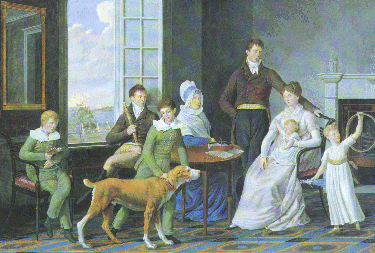
|
Robert R.
Whale. (1807 -
1887)
View of Hamilton (1853), Oil on canvas, 90.6 X 120.8 cm
|
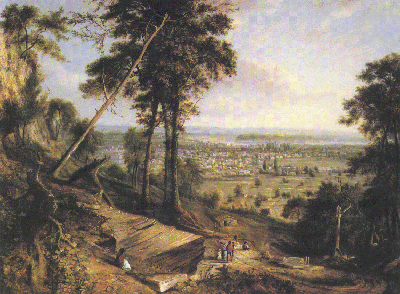
|
Robert
R. Whale was part of a large English artist immigration to Canada in
1852. Whale was in his forties when he came to Canada and resided primarily
near Brantford. The bulk of his work came from commissions for portraits
and landscape paintings. What makes his work interesting is that he combined
two popular genres: awe-inspiring aspects of the New world landscapes and
a "portrait" of one of the day's most progressive in technical developments.
Whale's paintings encompassed broad and idealized views of
nature.
|
Ozias
Leduc. (1864
-1955)
L'Enfant au pain (1892-99), Oil on canvas, 50.7 X 55.7 cm
|
Ozias
Leduc's work assumes simple and solid values that contrast extravagant
decoration..
Leduc
was a product of rural Quebec life; a life filled with obstacles and strife.
His work expresses lies, not in the objects that can be seen but in what
cannot be seen; the emotions that grow out of making music.
|

|
Tom
Thomson. (1877
-1917)
White Birches , Oil on board, 21.6 X 26.7 cm
|
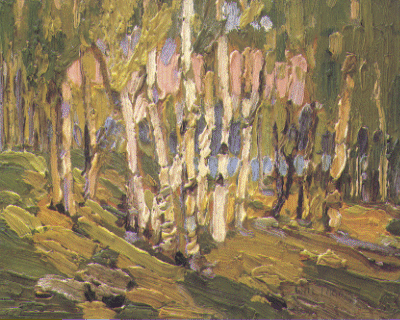
|
Tom Thomson could be described as a loner.
He was somewhat self conscious about his art work at first. Thomson was in
his 30's before he began to paint seriously. He laboured as a designer and
illustrator in Toronto at the firm of Grip Ltd.. It was here that he met
J.E.H MacDonald and Arthur Lismer, who encouraged him to paint. Thomson absorbed
the atmosphere and talents of those artists who would come to form the
Group of
Seven; A.Y. Jackson,
Arthur
Lismer and
Lauren
Harris were among the group. They saw in thomson an ability to capture
the perception of the landscape and the character of
painting.
|
A.Y.
Jackson. (1882
-1974)
Lake Cognaschene, (1920), Oil on canvas, 63.5 X 81.3 cm
|
It can be said that
A.Y.
Jackson represented the heart of the
Group of
Seven. His commitment to advocating membership to the Group was key to
the formation of the Canadian Group of Painters in 1933. Jackson remained
a pivotal figure in Canadian Art. The beginnings of Jackson's career was
difficult. He began work at the age of twelve, earning a living as a commercial
artist by day, while taking art classes at night. He made brief visits to
Europe absorbing all the culture he could. He was urged to join the Toronto
painters in 1913; this period was to usher in his most influential
work.
|
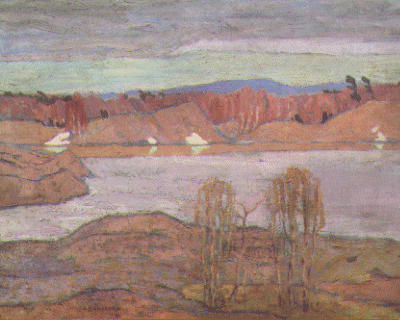
|
Edwin
Holgate. (1892
-1977)
Ludivine, (1930), Oil on canvas, 76.3 X 63.9 cm
|
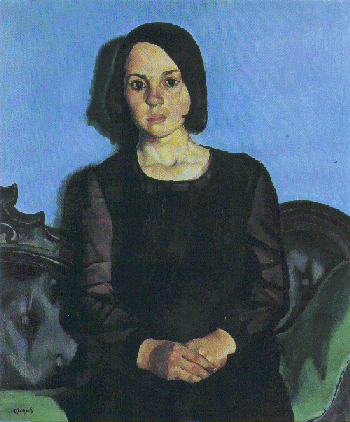
|
Edwin
Holgate joined the
Group of
Seven in 1930 and later became a member of the Canadian Group of Painters.
He was an active member of the art scene in Montreal all through the 1920's
and 30's. He travelled to Paris in 1912 with the army and spent three years
there. He studied with a Russian Painter named Adolf Milman. It was in Paris
where he met james Wilson Morrice. Holgate became inspired by Morrice's work
and soon Morrice could be seen as a major influence in Holgate's work.
|
Alfred
Pellan. (1906
-1988)
Floraison, (c. 1956), Oil on canvas, 180.3 X 146.1 cm
|
The work of
Alfred
Pellan encompasses many different styles that range from the
abstract
to the representational. In the 1940's, Pellan began to develop themes that
he would expand on in later years. In the 1950's Pellan travelled to Paris
for three years. It was in Paris that he had a major exhibit at the
Musee National d'Art
Moderne in 1955. It was due, to a large part, to this show that Pellan
garnered the respect of and was accepted by the modern
masters.
|
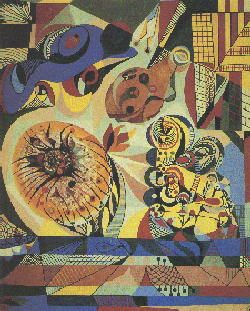
|
Alex
Colville. (born
1920)
To Prince Edward Island, (1965), Acrylic emulsion on masonite,
61.9 X 92.5 cm
|
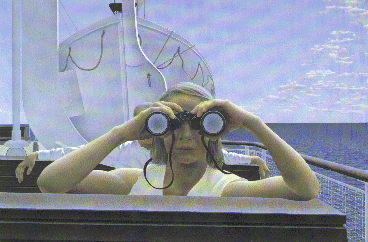
|
Complex geometric schemes compose the work
of Alex Colville. Colville
takes great pains to carefully measure and place subject matter. His
paintings assume an almost cold asymmetrical and perfectly balanced harmony.
Almost all of Colville's work deals with two distinct worlds; the world of
human beings and the world of animals.
|
Patterson
Ewen. (born 1925)
The Great Wave: Homage to Hokusai, (1974), Mixed media on gouged
plywood, 243.9 X 243.9 cm
|
Ewen studied geology at McGill University after
returning home from the war. He left after a year and decided to pursue art.
In the 1950"s Ewen associated with artists who were following the work of
Paul-Emil
Borduas. In 1968 Ewen left Montreal for London, Ontario. It was here
that he became dissatisfied with the direction of his work. Thus he began
experimenting with new techniques in painting and he began to recall images
of childhood fascinations and started to incorporate these images into his
work.
|

|
Joanne
Tod. (born 1953)
Having Fun? The Time of Our Lives, (1984), Oil on canvas, two
panels each, 199.0 X 199.0 cm
|
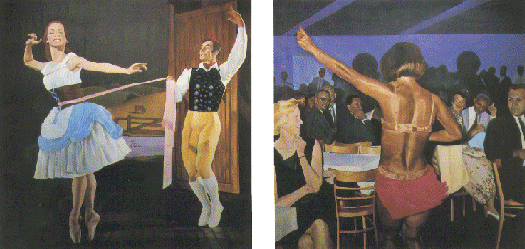
|
The work of
Joanne Tod exudes a subtlety
that hides its meaning deep beneath each initial appearance. Her work assumes
the role of photographs. Just as photographs appear candid and natural, so
does the work of Tod. She works with this ambiguity, this ability to layer
the surfaces of appearances, contrasting the naturalness of situations. The
blatant and stark directness of her images seem to display the reality of
the situation and then, destroys it.
|
ART IS PERSONAL
ART IS PEOPLE
ART SHAPES
MATERIAL
ART HAS
STRUCTURE
ART RECORDS
HISTORY
ARTISTS ARE SOCIAL
CRITICS
Knowing how to view art becomes a step
closer to the understanding and to the appreciation of art as it connects
to your personal experiences.
When viewing art it is important
to move from personal and individual responses to a wider understanding of
the cultural, intellectual, and spiritual values of objects and works of
art.
Important things to consider when looking
at works of art:
What words come to mind when you look
at these art works?
What kinds of colours do you
see?
What devices or sections call our
attention?
What kind of feelings are
invoked?
Why do you think the artists' motivation
was in the creation of this work?
Describe the art work in as many words
as you can.
What technique(s) has the artist
used?
THE END









